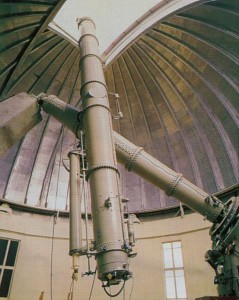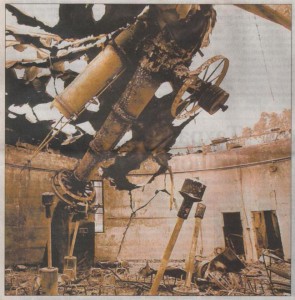Yale Parallax Refractor66 cm (26 inch) |
 |
Index:
Summary; History; Current; Technical; Sources; Links; Gallery:
In brief
Important Contributions:
Groundbreaking work was done with this telling measuring the parallax and proper motions of stars in the Southern Hemisphere.
Description:
- This instrument was specially designed and built for the determination of trigonometrical parallaxes.
- The instrument used a 26-inch refractor that was a specialist telescope designed for the task. To measure a star’s parallax, it is essential for the star to be high in the sky when the relevant photographs are taken – so there was no need for the telescope to be wholly maneuverable, or to cover the whole sky. As long as it could be pointed some way to either side of the meridian, it would serve its purpose very adequately.
- The program to measure parallax in the Southern Hemisphere came to an end in 1952. Due to growing light problems in Johannesburg, it was decided to move the telescope to Mount Stromlo in Australia.
- On 18 January 2003 a bush fire destroyed Mount Stromlo Observatory with all its instruments. The 26-inch refractor was also destroyed. (A section of the lost and found page is dedicated to this tragedy)
Historical Background
Owners:
Yale University.
Where Located:
- Yale Observatory (1925 – 1951)
- Mount Stromlo, Australia (1956 – 2003)
Postscript:
Concerning the maneuverability of the telescope, there was one great telescope which was even more restricted and whose tube was swung between two massive stone walls so that it could point only a short way to either side of the meridian. This was the 72-inch reflector built at Birr Castle in Ireland, by the third Earl of Rosse in 1845 – and with which he discovered the spiral forms of the systems we now know to be external galaxies. However, Lord Rosse followed this pattern not because he wanted to, but because with the limited engineering facilities available at the time he had no choice. The 72-inch was last used in 1909, and is still to be seen in the Castle grounds. Up to until the middle of the First World War, it remained the largest reflector in the world, though it had a metal mirror and was by no means the equal of some of the smaller but newer instruments. [Copied from Moore, p.112]
Current Information
Present Location:
Mount Stromlo Observatory in Australia
Owner:
Status:
On 18 January 2003 a bush fire destroyed Mount Stromlo Observatory with all its instruments. The 26-inch refractor was also destroyed.
Condition:
Damaged beyond repair.
Technical Details
Type: Photographic Refractor
Aperture: 26 inch (66 cm)
Focal Length: “Long focal length” [Moore, p.112.]
Lens:
Mounting:
Attachments:
Manufacturer:
Operational History:
Building:
- Johannesburg: As the telescope could not rotate, they build “an observatory of a very unusual kind. There was no majestic dome, or even a turret; the observatory took the form of an asymmetrical brick structure, with a slit in the roof which could be opened but which did not rotate”. [Copied from Moore, p.111.]
Picture of building in Moore, P. & Collins, P., Astronomy in Southern Africa, p.112.
Sources:
Link to the Main Bibliography Section and more information about Sources.
Documentation:
Pictorial Sources:
Bibliography:
- Moore, P. & Collins, P., Astronomy in Southern Africa, p111 – 113. (General Source)
- Stoy, R.H., Astronomy in South Africa, A History of Scientific Endeavour in South Africa, Royal Society of South Africa, 1977.
- Smits P. A Brief History of Astronomy in Southern Africa. (Unpublished).
Links
Gallery

The 26 inch Yale telescope after it’s move to Mount Stromlo Observatory in Australia.
Source: Personal communication with Wayne Orchison

The 26 inch Yale after the fire at Mount Stromlo Observatory in Australia. On 18 January 2003 a bush fire destroyed approx. 500 houses and the Observatroy. Five other telescopes were destroyed with the 26 inch.
Source: Personal communication with Wayne Orchison
